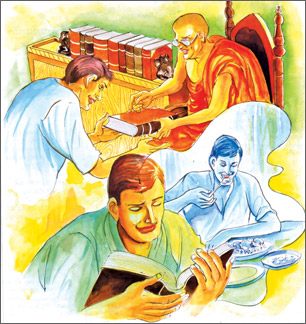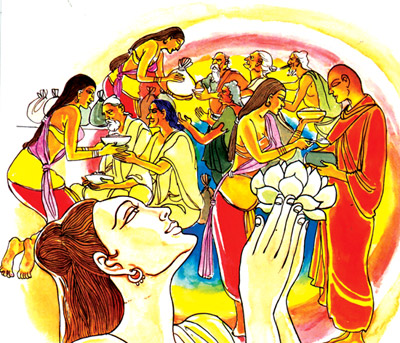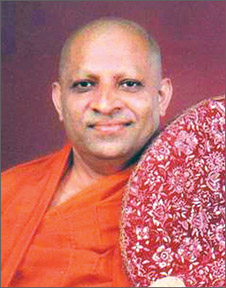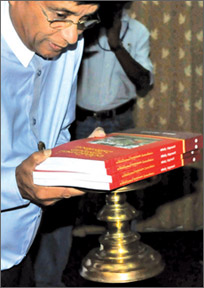|
Buddhist Spectrum
Gift of Dhamma excels all other gifts
Premasara EPASINGHE
There is a famous saying 'Gift of Dhamma surpasses all gifts'. When
former Directress of Education Dr Kamala Peiris, 'Mother of Sri Lanka's
Primary Education', a highly respected educationist, the gracious lady,
a regular reader of Thursday's 'Buddhist Spectrum' in the 'Daily News',
gifted me a small booklet, 'Why Worry?' in appreciation of my Buddhist
articles.
 I was on cloud nine. This booklet was written by erudite scholar monk
K Sri Dhammananda. Dr Peiris authored two valuable books titled 'Tiny
sapling sturdy tree' and 'Weaving our future together'. Presenting me
the valuable book 'Why Worry?', she wrote these lines, “Dear Premasara,
may your writings be enriched by the contents of this small book.” I was on cloud nine. This booklet was written by erudite scholar monk
K Sri Dhammananda. Dr Peiris authored two valuable books titled 'Tiny
sapling sturdy tree' and 'Weaving our future together'. Presenting me
the valuable book 'Why Worry?', she wrote these lines, “Dear Premasara,
may your writings be enriched by the contents of this small book.”
Gift of Dhamma excels all other gifts. Although Dr Peiris states in a
'small book', I consider it as big as an elephant.
Dear madam, your kind thought and gesture motivated me to write this
piece which reminded me of a very valuable stanza uttered by Buddha,
which is woven round the king of Devas – Sakka, about Dhamma the
greatest gift that anyone can possess.
The questions raised by the God's were, what are the best gifts,
flavours, and the pleasures one can possess?
The Buddha replied:
Sabbadanam Dhammadanam Jinati
Sabbarasam Dhammarasam Jinati
Sabba Rajim Dhammaraji Jinati
Tanhakkayo Sabbadukkam Jinati
(Dhammapada – Chapter 24 – Tanhe Vagga – Craving – stanza 354)
The gift of the Dhamma excels all other gifts,
The flavour of Dhamma excels all other flavours,
The pleasure in Dhamma excels all other pleasures,
Extinction of craving conquers all pain.
You may have heard of this valuable stanza several times. Sometimes,
you may be not aware of the details, when, where, to whom, Buddha
uttered the above stanza or verse.
To begin with, the Enlightened One, while residing at the Jetavana
monastery, recited this verse with reference to above four questions
raised by king of Devas – Sakka.
Once at a meeting of Devas – Gods, in the abode of Tavatimsa heaven,
four questions were raised. They were arguing about the four questions.
Then, Sakka and Gods approached Buddha to obtain an answer.
From that day onwards, Buddha kindly instructed all monks to share
merit of all their good deeds with all beings. This practice is followed
to date. Presently, all beings from 31 bhumis, share merit whenever a
good deed is done.
Free of emotions
Miran Perera
Buddhism has always been concerned with feelings emotion, sensations
and cognition. The Buddha points both to cognitive and emotional causes
of suffering. The emotional cause is desire and its negative opposite
aversion. The cognitive cause is ignorance of the way things truly
occur, or of three marks of existence; that all things are
unsatisfactory impermanent and without essential self.
The noble eightfold path is from this psychological viewpoint an
attempt to change patterns of thought and behaviour. It is for this
reason that the first element of the path is right understanding
(Samma-ditthi) which is how ones mind views the world. Once the brahmin
Janussoni approached Lord Buddha and addressed him thus; I maintain
Master Gotama and hold the view that there is no mortal who does not
fear death, who is not afraid of death.
 Within a lengthy answer Lord Buddha said among other things; (Brahmin
there is a person who has no doubts and perplexity about the good
Dhamma, a person who is free from lust for sensual pleasures, free from
desire and affection for them, free from thirsting and fevering after
them, free from craving for sensual pleasures and there are persons who
are free from lust for the body, and there are persons who have not done
anything evil, cruel or wicked but done what is good and wholesome.
These persons have gained certainty in the Dhamma and they do not fear
death and are not afraid of death. Within a lengthy answer Lord Buddha said among other things; (Brahmin
there is a person who has no doubts and perplexity about the good
Dhamma, a person who is free from lust for sensual pleasures, free from
desire and affection for them, free from thirsting and fevering after
them, free from craving for sensual pleasures and there are persons who
are free from lust for the body, and there are persons who have not done
anything evil, cruel or wicked but done what is good and wholesome.
These persons have gained certainty in the Dhamma and they do not fear
death and are not afraid of death.
Spiritual ills
Hence the Buddha Dhamma could mutate the fear of death into one of
happiness, for those who properly follow it. Throughout the history of
Buddhism the Buddha has been described as a doctor treating spiritual
ills; The path of practice He taught has likewise served as therapy for
suffering hearts and minds. This understanding of the Buddha and his
teachings dates back to the earliest texts, but its meaning for
contemporary practitioners has become more relevant than ever. Buddhist
meditation is often touted as a form of healing and many
psychotherapists now recommend that their patients try meditation as
part of their treatment. But the Buddha understood, and experience has
shown that meditation on its own can't provide a total therapy, but
practising the true Dhamma, Buddhism mutates to happiness, all
adversity.
The Buddha states in the Rohitassa Sutta; only in thus fathom long
human body with its perceptions and thoughts do I proclaim Loka Dukka,
the origin of Loka Dukka, the cessation of Loka Dukka and the path
leading to the cessation of Loka Dukka. Loka Dukka, here means the world
of physical and mental suffering. The above taken in the context of the
following statements of the Buddha; Mind the forerunner of all Dhamma
and is the highest. All own the sovereignty of the mind.
Language barriers
It reiterates the fact that the Buddha Dhamma is not only applicable
to Buddhists, but to all humans who own the sovereignty of their mind
irrespective of religious bias, status, wealth, caste, creed or language
barriers. From the Buddhist view thoughts influence emotions which in
turn affect behaviour and brain functions. Most rational thinkers today
believe that the scientific view is disempowering because by emphasizing
external factors there seemed little the individual could do to
influence his emotions and thoughts. They find the Buddhist view more
acceptable because it seemed that we could do something to help
ourselves.
Buddhists and scientists differ on what is considered a destructive
emotion. For example scientists say that sadness disgust and fear are
negative emotions in the sense that they are unpleasant to experience.
However, from a Buddhist view point two types of sadness disgust and
fear are discussed. One is based on distortion, interferes with
liberation and is to be abandoned. Another type of sadness helps us.
When the prospect of having one rebirth after another in Samsara makes
us sad and even fills us with disgust and fear.
External expression
They are positive because they prompt us to generate the
determination to be free from cyclic existence and attain liberation.
Such sadness disgust and fear are positive because they are based on
wisdom and stimulate us to practise and gain realization of Buddhism.
Therapy is aimed more at changing the external expression of the
emotions than the internal experience of them. Buddhism on the other
hand believes that destructive emotions themselves are obstacles and
need to be eliminated to have happiness. Over and over again the Buddha
uses the images of heat and fire to indicate the states of
dissatisfaction and suffering induced by passion greed hatred and
delusion in all their multifarious forms. Similarly He uses the images
of shade and coolness to indicate the state of pure transcendence. Since
Nibbana is the ultimate goal of Buddhist practice it is arguable that it
should be regarded as the most significant of terms in the Pali canon.
What is immediately clear is that the term Nibbana refers to the realms
of heat and coolness to fire and its quenching.
Once the Buddha said; Bhikkhus! All is burning and what Bhikkhus is
that all that is burning? The eye, the forms, the eye consciousness, the
eye contact, all burns. With what? Burning with fire of passion, fire of
hatred, fire of delusion. Burning with birth, aging, death, sorrow,
lamentation, pain, grief, despair. The Buddha says; seeing thus Bhikkhus
the wise noble disciple experiences disenchantment. Experiencing
disenchantment they become dispassionate.
To be continued
Timeless journey
Richard Basnayake
The Most Ven. Mahanayake Thera of the Malwatta Chapter, Thibbatuwawe
Sri Siddhartha Sumangala Thera was 68 years old on May 30. He was born
in a beautiful village, Thibbatuwawe, in “Kohonsiya Pattuwa”, to the
South of Matale district.
 |
|
Most Ven.
Mahanayake Thera
of the Malwatta Chapter,
Thibbatuwawe Sri Siddhartha
Sumangala Thera |
Bandaranayake Wasala Mudali Tikiri Bandara Nilame of Thibbatuwawe
Walauwa was his father. His loving mother was Karalliyadda Idama Walauwe
Loku Kumarihamy. He had two elder sisters and the little “Malli” was
named Thibbatuwawe Walauwe Loku Bandara, though he was small in stature.
Loku Bandara was a nice little boy that his maternal grandfather
“Loku Aththa” loved him so much and wanted his grandson to be educated
at Werapitiya village near Teldeniya where his grandparents lived. He
had his primary education at Werapitiya Kanishta Vidyalaya - a primary
school. He came to Thibbatuwawe only during the school vacation. Here
too, he enjoyed the village life with his friends as an ordinary lad.
The parents loved him very much as he was the only boy in the family and
the two sisters were very much attached to the cute little “Malli” of
their family.
Ordination:
After his primary education he was ordained as a “Samanera Bhikku” -
a Novice Monk on 10th June 1957 at the age of 13 years under the
preceptorship and tutelage of the Most Ven. Purijjala Sri Siddhartha
Saranankara Mahanayake Thera and the Most Ven. Thibbatuwawe Sri
Siddhartha Medankara Nayake Thera of Ridee Viharaya, Kurunegala.
Pirivena Education:
He entered Sri Sangaraja Pirivena, Kandy after his ordination and
studied the fundamentals of Dhamma, Pali, Sanskrit, Sinhala, traditional
religious customs and manners of the Malwatta Chapter under the able
guidance and tetulage of the Most Ven. Amunugama Rajaguru Vipassi
Mahanayake Thera of the Malwatta Chapter, the Most Ven. Wimalakeerthi
Sumana Panditha, Sirimalwatte Anandhabidhana Mahanayake Thera, Rajakeeya
Panditha Ven. Pahamune Dharmakeerthi Sri Saranankara Anunayake Thera,
Rajakeeya Panditha Ven. Rambukwelle Sri Sumangalabhidana Thera,
“Lekakadhikari” - General Secretary – Karaka Sanga Sabha and Ven.
Panditha Ratninde Sri Anomadhassi Thera. With all distinctions he
completed his higher education in this Pirivena.
Higher ordination
In 1964, at the age of 20 years, he received his higher ordination,
named “Wahalanaga” under the preceptership of the Most Ven. Amunugama
Rajaguru Vippassi Mahanayake Thera at the “Seemamalakaya” of Malwatta
Maha Viharaya.
After the higher ordination, he was entrusted with the “Thewawa”
ceremony of Sri Dalada Maligawa, which is one of the most difficult and
sacred ceremonies, both Malwatta and Asgiriya Chapter Bhikkus have to
perform every year. He was appointed to perform these highly religious
rituals in 1965, 1979, 1981 and 1992 with the guidance of the Most Ven.
Mahanayake Theras at that time. A special mention must be made about the
profound knowledge and the education he had to perform these rituals as
they were highly religious and sacred.
New Responsibilities:
He was appointed a “Karaka Sanga Sabhika”, to the highest body of
administration of the Malwatta Chapter in 1968, when he was only 24
years old, by the Most Ven. Amunugama Rajaguru Vipassi Mahanayake Thera.
On 10th May 1979 he was unanimously appointed as the “Upa Lekakadhikari”
- Assistant General Secretary and in 1985 November 9 to the post of
“Lekakadhikari” - General Secretary by the Most Ven. Wimalakeerthi Sri
Sumana Panditha Anandhabidhana Mahanayake Thera of the Malwatta Chapter.
He performed his duties as the General Secretary, to the utmost
satisfaction of the “Sanga Sabha”. In 1990, January 5 he was appointed
the Senior Member of the “Karaka Sanga Sabha” by the Most Ven.
Rambukwelle Dharmarakshitha Vipassiyabhidhana Mahanayake Thera.
Appointed as Anunayake Thera:
When, Ven. Rambukwelle Dharmarakkitha Ratanapala Sobhitabhidana
Anunayake Thera passed away, Ven. Thibbatuwawe Sri Siddhartha Sumangala
Thera was appointed as the Anunayake Thera one of the highest posts, on
13th May 1992.
Services rendered as the Chief Incumbent of Ridee Viharaya,
Kurunegala
He was appointed as the Viharadhipathi of historic Ridee Viharaya in
1974 and also to some smaller temples around Ridee Viharaya,
He built a new “Dharma Salawa” - Sermon Hall with all modern
facilities
Electricity to Ridee Viharaya and other smaller temples were provided
with his guidance
“Kele Pansala” an ancient cave temple close to Ridee Viharaya was
renovated and was made a meditation centre with all modern facilities.
In addition to his religious activities he took the initiative to
build Rideegama town with modern facilities.
He built two-storied buildings in the middle of the town and one was
made a Buddhist Centre and the other the Public Library named Sri
Siddhartha Library.
He donated all the medical equipment necessary to Rideegama hospital
and made it a model rural hospital.
A new “Wahalkada” - an entrance was erected at the Rideegama Devalaya
with his guidance.
Appointment as the Mahanayake Thera
When the Most Ven. Rambukwelle Sri Dharmarakkitha Vipassibhidhana
Mahanayake Thera of the Malwatta Chapter passed away on 7 June 2004, the
Most. Ven. Thibbatuwawe Sri Siddhartha Sumangala Anunayake Thera was
unanimously elected to this highest post of Mahanayake Thera of the
Malwatte Chapter on 20th June 2004 by the “Karaka Sanga Sabha”. He was
officially appointed the 26th Mahanayake Thera of the Malwatta Chapter
and the Act of Appointment was presented on 16th August 2004, at the
historic “Magul Maduwa” in Kandy by the then President Madam Chandrika
Bandaranaike Kumaratunga.
Study on revered places
 Atamasthana or Eight sacred places are a series of locations in Sri
Lanka where the Buddha had visited during his three visits to the
country. The sacred places are known as Jaya Sri Maha Bodhiya,
Ruwanwelisaya, Thuparamaya, Lovamahapaya, Abhayagiri Dagaba,
Jetavanarama, Mirisaveti Stupa and Lankarama. They are situated in
Anuradhapura, the capital of the ancient Anuradhapura Kingdom. Atamasthana or Eight sacred places are a series of locations in Sri
Lanka where the Buddha had visited during his three visits to the
country. The sacred places are known as Jaya Sri Maha Bodhiya,
Ruwanwelisaya, Thuparamaya, Lovamahapaya, Abhayagiri Dagaba,
Jetavanarama, Mirisaveti Stupa and Lankarama. They are situated in
Anuradhapura, the capital of the ancient Anuradhapura Kingdom.
The sacred city of Anuradhapura exerted a considerable influence on
the development of architecture in the country during several centuries.
The city is nominated as a UNESCO World Heritage Site in 1982, it lies
205 km north of the current capital Colombo in island's North Central
Province, on the banks of the historic Malvathu Oya.
According to the Mahavansa the sacred city was found around 350 BC by
Pandukabhaya, the first king of the Anuradhapura kingdom and sixth since
the arrival of Vijaya. It eventually become the principal shrines of
Buddhism including the branch planted of the sacred fig tree, Bodhi tree
from Bodhgaya, under which Siddharta attained spiritual enlightenment
and supreme wisdom. The sacred tree brought there in the third century
BC during the second mission, led by Sangamitta, a Buddhist nun and
daughter of Emperor Ashoka. The relics of Buddha have, moreover, shaped
the religious topography of Anuradhapura, where the Thuparamaya was
built by Devanampiya Tissa in the 3rd century BC to house the clavicle
of Buddha, an important religious relic presented by Emperor Ashoka.
  The city's apogee was reached under the reign of Dutthagamani who, in
161 BC, defeated the South Indian invader Elara re-establishing Buddhism
in the place of Brahminism and endowed the site with extraordinary
monuments including the Mirisaveti Stupa, Ruwanwelisaya, and the Brazen
Palace. The city flourished for 1,300 years, then was abandoned after an
invasion in 993. The city's apogee was reached under the reign of Dutthagamani who, in
161 BC, defeated the South Indian invader Elara re-establishing Buddhism
in the place of Brahminism and endowed the site with extraordinary
monuments including the Mirisaveti Stupa, Ruwanwelisaya, and the Brazen
Palace. The city flourished for 1,300 years, then was abandoned after an
invasion in 993.
Later hidden away in dense jungle for many years, the splendid site,
with its palaces, monasteries and monuments, is now accessible once
again.
Mahinda Relapanava is one scholar who recently authored a book on
these eight sacred places. The significance of the work is that he
focused on heading the sacred places, which is a difficult job.
‘Atamastanaye Anunayaka Thanantaraya’, which means ‘Deputy Incumbency
of the Eight Sacred Places’ was recently launched as a Sarasavi
publication.
Pictures by Saman Sri Wedage
|



